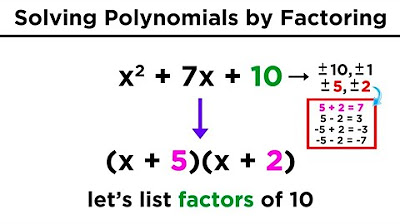Multiplying Binomials by the FOIL Method
TLDRThe video explains the process for multiplying polynomials, starting with monomials and progressing to multiplying binomials. It introduces FOIL method as a way to systematically multiply two binomials by distributing each term in one binomial across the other. It explains the reasoning and common mistakes in FOIL, going through step-by-step examples. Finally, it extends the lesson to multiplying a binomial by a trinomial, and a trinomial by a trinomial, applying the same techniques but with more steps. The goal is to provide students a clear, methodical process for multiplying polynomial expressions.
Takeaways
- 😀 FOIL stands for First, Outer, Inner, Last and provides a structured way to multiply two binomial expressions
- 😊 When multiplying monomials, the coefficients multiply and the variables multiply
- 😃 Use the distributive property to multiply a monomial by a binomial
- 😉 Common mistakes when FOILing include writing down the wrong sign on a term
- 🤓 Don't worry about whether terms will add or subtract, just write down the signs as they are
- 🧐 To multiply a binomial by a trinomial, multiply each term of the binomial by the trinomial
- 👍 There will be more steps when multiplying larger expressions, but the process is the same
- 😎 Multiplying a trinomial by a trinomial results in 9 terms before simplifying
- 🤔 Always check for like terms that can be combined after multiplying polynomials
- 😇 The key is to methodically apply the distributive property multiple times when multiplying
Q & A
What does FOIL stand for and what is its purpose?
-FOIL stands for First, Outer, Inner, Last. It is a mnemonic device to remember which terms to multiply when foiling (multiplying) two binomial expressions.
How do you foil two binomial expressions?
-To foil two binomial expressions: 1) Multiply the first terms 2) Multiply the outer terms 3) Multiply the inner terms 4) Multiply the last terms.
What is the most common mistake made when foiling binomial expressions?
-The most common mistake is writing the wrong sign for a particular term. It's important not to get confused by the plus or minus signs between the binomial terms.
What happens when you multiply a binomial by a trinomial?
-When multiplying a binomial by a trinomial, you essentially foil twice - first multiply the first binomial term across the trinomial and then multiply the second binomial term across the trinomial.
How do you multiply monomials?
-To multiply monomials, multiply the coefficients and variables separately. For example, (2x)(3x) = 6x^2.
What is the result of foiling (x+3)(x-2)?
-Foiling (x+3)(x-2) results in: x^2 + x - 6
What are the key things to remember when foiling?
-The key things to remember are: 1) Use the FOIL method 2) Pay attention to signs 3) Don't combine like terms until the end
What happens after you foil two expressions?
-After foiling, combine any like terms and arrange the resulting polynomial in descending order by exponents.
What is a binomial expression?
-A binomial expression is a polynomial with two terms, typically with plus or minus signs between them.
What is a common mistake students make when multiplying polynomials?
-A common mistake is incorrectly applying the distributive property by not multiplying each term properly across the other polynomial.
Outlines
🤓 Introduction to FOIL method for multiplying polynomials
This paragraph introduces the concept of multiplying polynomials, starting with simple cases like monomials and monomials times binomials. It then introduces the FOIL (First, Outer, Inner, Last) method as an easy way to multiply two binomials by distributing each term in one binomial across the terms in the other binomial.
😃 Applying FOIL method to more complex polynomials
This paragraph provides examples of using the FOIL method to multiply more complex polynomials, like a binomial times a trinomial. It explains how the process is the same as simpler cases, just with more steps from repeatedly applying the distributive property.
Mindmap
Keywords
💡FOIL
💡binomial
💡distribute
💡monomial
💡trinomial
💡polynomial
💡term
💡coefficients
💡variables
💡like terms
Highlights
To multiply polynomials, we can use the FOIL method which stands for First, Outer, Inner, Last.
When foiling, multiply the first terms, outer terms, inner terms, and last terms of the binomials.
The FOIL method ensures we correctly distribute each term of one binomial across the other binomial.
Don't get confused by the signs between the binomial terms, just focus on multiplying the terms.
When listing the result terms, don't think about whether they will be added/subtracted, just list with the sign.
To multiply a binomial by a trinomial, multiply the first binomial term across the trinomial, then the second term.
Multiplying longer polynomials involves more steps since we need to use the distributive property more times.
Multiplying a trinomial by a trinomial results in 9 terms before condensing any like terms.
Monomials multiply easily since the numbers and variables all multiply.
A common foiling error is writing the wrong sign for a term.
Apply the distributive property twice when foiling.
Like terms can be combined at the end after foiling.
For monomial times binomial, use the distributive property.
Foiling works by distributing each binomial term across the other binomial.
Foiling ensures a consistent process so mistakes are less likely.
Transcripts
5.0 / 5 (0 votes)
Thanks for rating:





